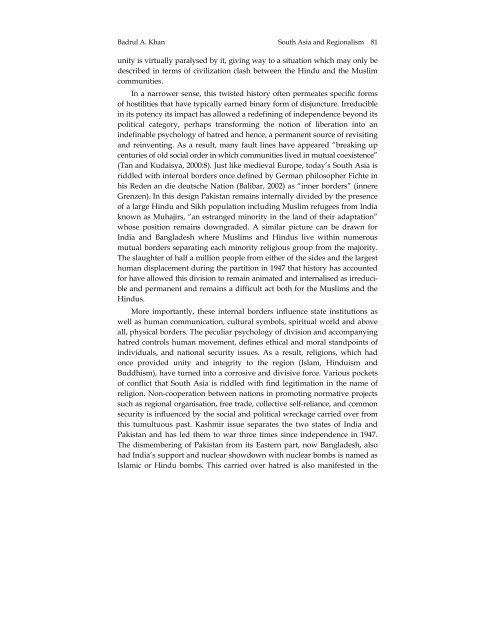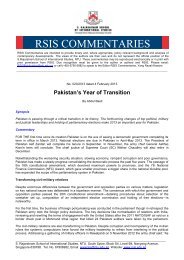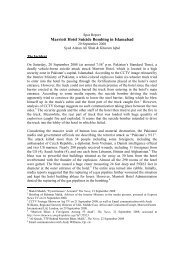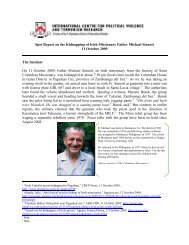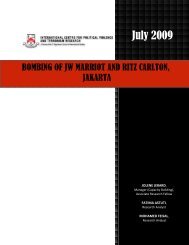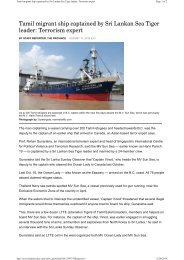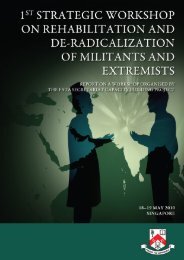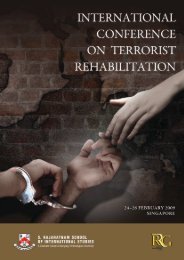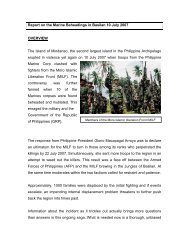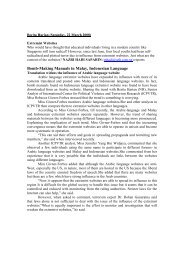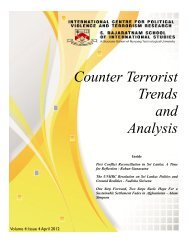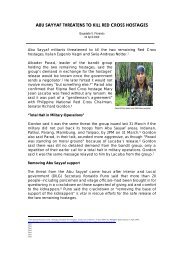Peace and Security Review, Vol.1 No. 2 - International Centre for ...
Peace and Security Review, Vol.1 No. 2 - International Centre for ...
Peace and Security Review, Vol.1 No. 2 - International Centre for ...
Create successful ePaper yourself
Turn your PDF publications into a flip-book with our unique Google optimized e-Paper software.
Badrul A. Khan South Asia <strong>and</strong> Regionalism 81<br />
unity is virtually paralysed by it, giving way to a situation which may only be<br />
described in terms of civilization clash between the Hindu <strong>and</strong> the Muslim<br />
communities.<br />
In a narrower sense, this twisted history often permeates specific <strong>for</strong>ms<br />
of hostilities that have typically earned binary <strong>for</strong>m of disjuncture. Irreducible<br />
in its potency its impact has allowed a redefining of independence beyond its<br />
political category, perhaps trans<strong>for</strong>ming the notion of liberation into an<br />
indefinable psychology of hatred <strong>and</strong> hence, a permanent source of revisiting<br />
<strong>and</strong> reinventing. As a result, many fault lines have appeared “breaking up<br />
centuries of old social order in which communities lived in mutual coexistence”<br />
(Tan <strong>and</strong> Kudaisya, 2000:8). Just like medieval Europe, today’s South Asia is<br />
riddled with internal borders once defined by German philosopher Fichte in<br />
his Reden an die deutsche Nation (Balibar, 2002) as “inner borders” (innere<br />
Grenzen). In this design Pakistan remains internally divided by the presence<br />
of a large Hindu <strong>and</strong> Sikh population including Muslim refugees from India<br />
known as Muhajirs, “an estranged minority in the l<strong>and</strong> of their adaptation”<br />
whose position remains downgraded. A similar picture can be drawn <strong>for</strong><br />
India <strong>and</strong> Bangladesh where Muslims <strong>and</strong> Hindus live within numerous<br />
mutual borders separating each minority religious group from the majority.<br />
The slaughter of half a million people from either of the sides <strong>and</strong> the largest<br />
human displacement during the partition in 1947 that history has accounted<br />
<strong>for</strong> have allowed this division to remain animated <strong>and</strong> internalised as irreducible<br />
<strong>and</strong> permanent <strong>and</strong> remains a difficult act both <strong>for</strong> the Muslims <strong>and</strong> the<br />
Hindus.<br />
More importantly, these internal borders influence state institutions as<br />
well as human communication, cultural symbols, spiritual world <strong>and</strong> above<br />
all, physical borders. The peculiar psychology of division <strong>and</strong> accompanying<br />
hatred controls human movement, defines ethical <strong>and</strong> moral st<strong>and</strong>points of<br />
individuals, <strong>and</strong> national security issues. As a result, religions, which had<br />
once provided unity <strong>and</strong> integrity to the region (Islam, Hinduism <strong>and</strong><br />
Buddhism), have turned into a corrosive <strong>and</strong> divisive <strong>for</strong>ce. Various pockets<br />
of conflict that South Asia is riddled with find legitimation in the name of<br />
religion. <strong>No</strong>n-cooperation between nations in promoting normative projects<br />
such as regional organisation, free trade, collective self-reliance, <strong>and</strong> common<br />
security is influenced by the social <strong>and</strong> political wreckage carried over from<br />
this tumultuous past. Kashmir issue separates the two states of India <strong>and</strong><br />
Pakistan <strong>and</strong> has led them to war three times since independence in 1947.<br />
The dismembering of Pakistan from its Eastern part, now Bangladesh, also<br />
had India’s support <strong>and</strong> nuclear showdown with nuclear bombs is named as<br />
Islamic or Hindu bombs. This carried over hatred is also manifested in the<br />
<strong>Vol.1</strong>, <strong>No</strong>.2 2008 pp.77-93


